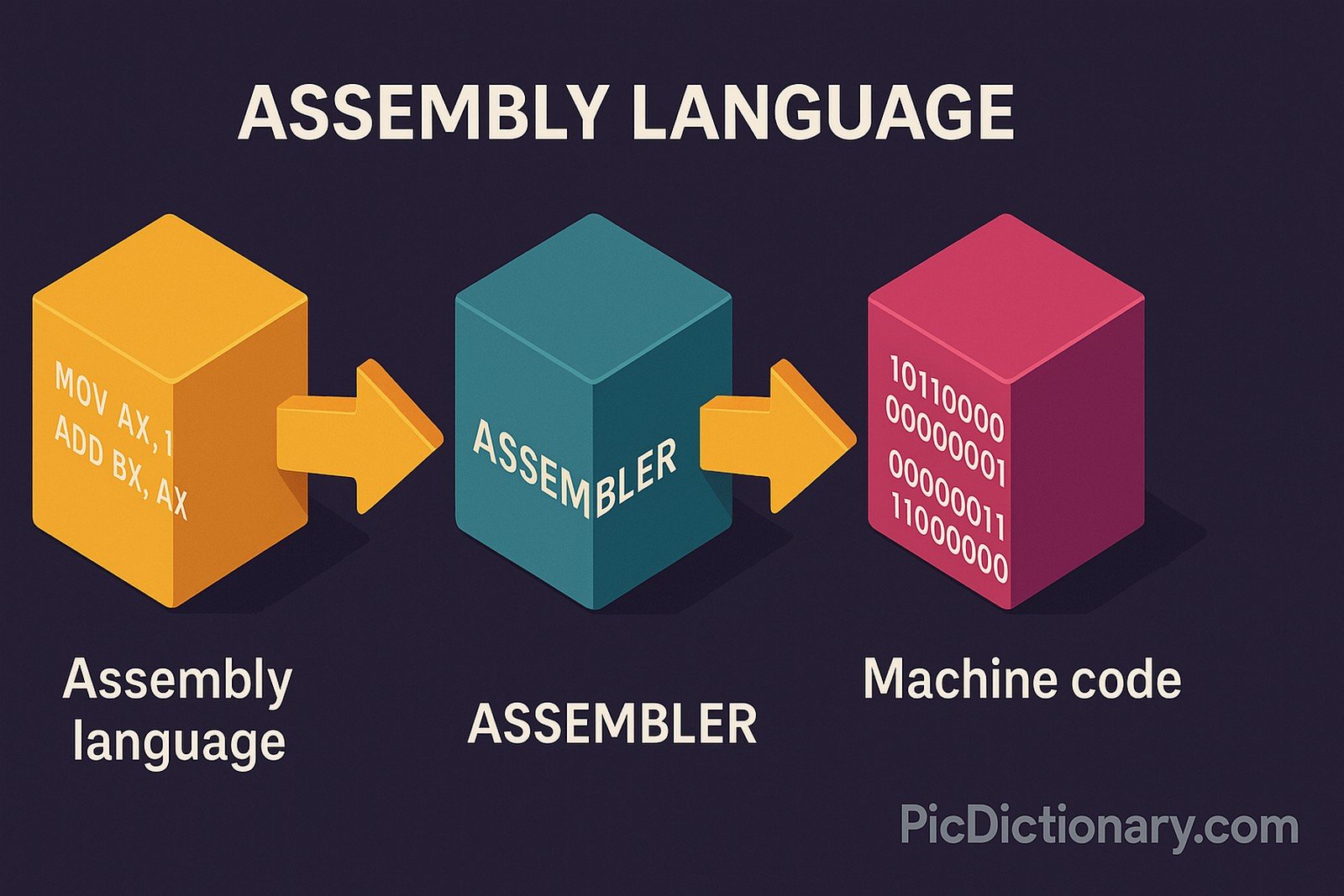Assembly Language
 (Representational Image | Source: Dall-E)
(Representational Image | Source: Dall-E)
Quick Navigation:
- Assembly Language Definition
- Assembly Language Explained Easy
- Assembly Language Origin
- Assembly Language Etymology
- Assembly Language Usage Trends
- Assembly Language Usage
- Assembly Language Examples in Context
- Assembly Language FAQ
- Assembly Language Related Words
Assembly Language Definition
Assembly language is a low-level programming language that provides a symbolic representation of a computer's machine code instructions. It serves as an intermediary between high-level languages and machine code, offering precise control over hardware while remaining more readable than raw binary or hexadecimal instructions. Each assembly language is specific to a particular processor architecture, such as x86, ARM, or MIPS, and is translated into machine code using an assembler.
Assembly Language Explained Easy
Imagine you have a robot that only understands a specific set of instructions, like "move left," "pick up," or "jump." Instead of speaking in a human language, you use a special code that tells the robot exactly what to do. Assembly language is like this—it gives a computer simple, direct instructions it can follow, but it's easier for humans to understand compared to raw 1s and 0s.
Assembly Language Origin
Assembly language dates back to the 1940s and 1950s when programmers needed a way to write instructions more efficiently than using pure binary code. Early computers, like the ENIAC, relied on direct machine code input, but assembly language evolved as a way to simplify programming while maintaining hardware control.
Assembly Language Etymology
The term "assembly" refers to the assembling of machine instructions in a human-readable form before they are converted into machine code by an assembler.
Assembly Language Usage Trends
Despite the dominance of high-level languages like Python and Java, assembly language remains crucial in embedded systems, operating system kernels, and performance-critical applications. It is commonly used in low-level hardware interaction, reverse engineering, and cybersecurity, where precise control over hardware and memory is required.
Assembly Language Usage
- Formal/Technical Tagging:
- Low-Level Programming
- System Programming
- Embedded Systems - Typical Collocations:
- "assembly language programming"
- "writing assembly code"
- "assembly language instructions"
- "assembly-level optimization"
Assembly Language Examples in Context
- Operating systems like Linux use assembly language for bootloaders and kernel optimizations.
- Embedded systems, such as microcontrollers in IoT devices, rely on assembly for efficient performance.
- Malware analysts use assembly to reverse-engineer and understand malicious code.
Assembly Language FAQ
- What is assembly language?
Assembly language is a low-level programming language that provides a human-readable form of machine instructions for specific computer architectures. - How does assembly language differ from machine code?
Machine code consists of raw binary instructions that the CPU executes, whereas assembly language provides a more readable format using symbolic mnemonics. - Why is assembly language still used today?
It is used for system programming, embedded systems, performance optimization, and reverse engineering due to its control over hardware. - What are some common assembly language instructions?
Common instructions include MOV (move data), ADD (addition), JMP (jump to another instruction), and CMP (compare values). - Is assembly language hard to learn?
Yes, compared to high-level languages, it requires a deep understanding of hardware, registers, and memory management. - Which processors use assembly language?
Different architectures have their own assembly languages, such as x86, ARM, and MIPS. - How does an assembler work?
An assembler translates assembly language code into machine code that the CPU can execute. - Can assembly language be used for modern applications?
Yes, it is used in security, game development (for performance optimization), and real-time systems. - Is assembly language faster than C or Python?
Yes, because it allows direct control over hardware and does not introduce additional overhead. - What tools are used for assembly language programming?
Common tools include NASM (Netwide Assembler), MASM (Microsoft Macro Assembler), and GNU Assembler (GAS).

Assembly Language Related Words
- Categories/Topics:
- Computer Architecture
- Embedded Systems
- System Programming
Did you know?
In 1993, a single assembly language instruction in the DOOM video game engine improved performance so much that it set the standard for first-person shooter games. The optimization trick, known as the "binary space partitioning algorithm," was instrumental in the game's success.
PicDictionary.com is an online dictionary in pictures. If you have questions or suggestions, please reach out to us on WhatsApp or Twitter.Authors | Arjun Vishnu | @ArjunAndVishnu

I am Vishnu. I like AI, Linux, Single Board Computers, and Cloud Computing. I create the web & video content, and I also write for popular websites.
My younger brother, Arjun handles image & video editing. Together, we run a YouTube Channel that's focused on reviewing gadgets and explaining technology.



Comments powered by CComment